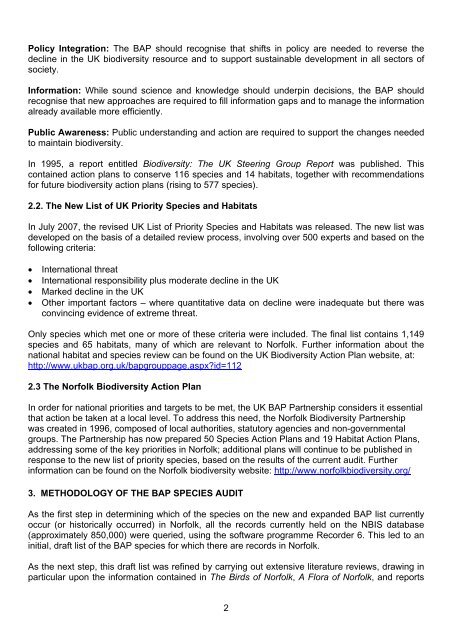NORFOLK BIODIVERSITY ACTION PLAN SPECIES DATA AUDIT ...
NORFOLK BIODIVERSITY ACTION PLAN SPECIES DATA AUDIT ...
NORFOLK BIODIVERSITY ACTION PLAN SPECIES DATA AUDIT ...
You also want an ePaper? Increase the reach of your titles
YUMPU automatically turns print PDFs into web optimized ePapers that Google loves.
Policy Integration: The BAP should recognise that shifts in policy are needed to reverse the<br />
decline in the UK biodiversity resource and to support sustainable development in all sectors of<br />
society.<br />
Information: While sound science and knowledge should underpin decisions, the BAP should<br />
recognise that new approaches are required to fill information gaps and to manage the information<br />
already available more efficiently.<br />
Public Awareness: Public understanding and action are required to support the changes needed<br />
to maintain biodiversity.<br />
In 1995, a report entitled Biodiversity: The UK Steering Group Report was published. This<br />
contained action plans to conserve 116 species and 14 habitats, together with recommendations<br />
for future biodiversity action plans (rising to 577 species).<br />
2.2. The New List of UK Priority Species and Habitats<br />
In July 2007, the revised UK List of Priority Species and Habitats was released. The new list was<br />
developed on the basis of a detailed review process, involving over 500 experts and based on the<br />
following criteria:<br />
• International threat<br />
• International responsibility plus moderate decline in the UK<br />
• Marked decline in the UK<br />
• Other important factors – where quantitative data on decline were inadequate but there was<br />
convincing evidence of extreme threat.<br />
Only species which met one or more of these criteria were included. The final list contains 1,149<br />
species and 65 habitats, many of which are relevant to Norfolk. Further information about the<br />
national habitat and species review can be found on the UK Biodiversity Action Plan website, at:<br />
http://www.ukbap.org.uk/bapgrouppage.aspx?id=112<br />
2.3 The Norfolk Biodiversity Action Plan<br />
In order for national priorities and targets to be met, the UK BAP Partnership considers it essential<br />
that action be taken at a local level. To address this need, the Norfolk Biodiversity Partnership<br />
was created in 1996, composed of local authorities, statutory agencies and non-governmental<br />
groups. The Partnership has now prepared 50 Species Action Plans and 19 Habitat Action Plans,<br />
addressing some of the key priorities in Norfolk; additional plans will continue to be published in<br />
response to the new list of priority species, based on the results of the current audit. Further<br />
information can be found on the Norfolk biodiversity website: http://www.norfolkbiodiversity.org/<br />
3. METHODOLOGY OF THE BAP <strong>SPECIES</strong> <strong>AUDIT</strong><br />
As the first step in determining which of the species on the new and expanded BAP list currently<br />
occur (or historically occurred) in Norfolk, all the records currently held on the NBIS database<br />
(approximately 850,000) were queried, using the software programme Recorder 6. This led to an<br />
initial, draft list of the BAP species for which there are records in Norfolk.<br />
As the next step, this draft list was refined by carrying out extensive literature reviews, drawing in<br />
particular upon the information contained in The Birds of Norfolk, A Flora of Norfolk, and reports<br />
2





